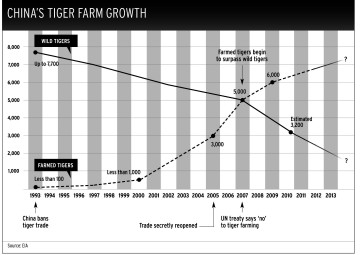When good news is bad for wild tigers
So far in 2015, the world has seen two rounds of effusive headlines about tigers “roaring back” in the wild—first from India, then from China. Unfortunately, wild tigers are nowhere near “roaring back” anywhere. In fact, their numbers are down by half what they were 20 years ago, while threats to their survival continue to escalate.
Sure, everyone prefers good news. And conservation groups must show donors that some sort of success has been bought with their dollars. But hyperbole can lead to the widespread false impression that wild tigers are much better off than they are.
“India’s tigers come roaring back,” World Wildlife Fund (WWF) announced on January 20. “India’s tiger population has significantly increased, according to the 2014-15 India tiger estimation report released today. Recent years have seen a dramatic rise in numbers….” The headline was parroted by news media around the world. But few, if any, that ran the story mentioned the fact that India’s tiger censuses are notoriously unreliable and sometimes dangerously wrong. In fact, just a month after the breaking good news, Indian and Oxford University scientists called India’s census techniques into question. “India’s tiger success story may be based on inaccurate census,” cautioned a headline in the UK’s Guardian. “Reports that India’s tiger population has risen by a third in four years are based on an unreliable count method,” said the subhead.
The second round of exaggerated good news came just as the Oxford report was throwing cold water on the first round. “This rare WWF video proves China’s tiger population is roaring back,” declared the Irish Examiner of camera-trap footage from 2014 showing an Amur tigress with two playful cubs about 20 miles from Northeast China’s border with Russia. “Many years of conservation work have led to this stunning footage—establishing conservation areas, building a population of prey animals and installing over one hundred infrared cameras in largely inaccessible areas,” said Shi Quanhua of WWF China.
What the story did not say is that wild tigers are all but extinct in China. The South China tiger is gone. There are an estimated 10 to 20 Amur tigers in Northeast China’s border region, and Indochinese tigers have been known to wander into Southwest China from Vietnam, although some experts say Vietnam’s wild tigers are now extinct. The fact that one tiger family is alive and well in Northeast China is indeed extraordinary, but it does not in any way constitute a “comeback” for wild tigers in China. Rather, it underscores the fact that the whole of China may have only one breeding tigress. Dale Miquelle, director of the Wildlife Conservation Society’s Russia Program, got it right when he told National Geographic: “Numbers may be slightly increasing in China, and the evidence of reproducing females is encouraging, but it is still a tiny population of, at most, a dozen or so. There is a long way to go before we can say that there is a viable population living in China.”
 This graphic from Blood of the Tiger offers a quick overview of wild tiger numbers over that past 20 years. As the number of tigers in China’s farms went up, those in the wild went down. The correlation: demand increased for wild tiger parts and products as the burgeoning farms tacitly promised a reopening of tiger trade between the lines—which is where most mainland Chinese ascertain news from their government.
This graphic from Blood of the Tiger offers a quick overview of wild tiger numbers over that past 20 years. As the number of tigers in China’s farms went up, those in the wild went down. The correlation: demand increased for wild tiger parts and products as the burgeoning farms tacitly promised a reopening of tiger trade between the lines—which is where most mainland Chinese ascertain news from their government.
Just because wild tigers are not being slaughtered for their bones and skins at the same rate that elephants and rhinos are being slaughtered for their ivory and horns, respectively, no one should not assume that tigers are any less threatened by the organized criminal syndicates supplying wealthy Asian elites investing in luxury products that will become priceless with extinction. In fact, estimates say there are far fewer wild tigers (3,200) than elephants (500,000) or rhinos (29,000), and tigers are more disbursed in dense forest and grassland, making them far more difficult to find and poach than elephants or rhinos.
In future, it would be better for wild tigers if conservation groups and the media who cover them would curb their enthusiasm when the rare bit of good news arises. Headline bait may attract donors and readers but it only diminishes the chance that wild tigers will attract the amount of time, money and effort required to save them from the deadly threats that grow larger by the day.
